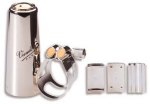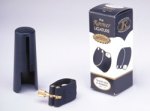
Equipment, Part II
Or, Stuff for the More Advanced Player
This Online Lesson is (c)
Ryan Fraser. All right reserved. NO COMMERCIAL DISTRIBUTION.
THIS LESSON HAS BEEN DOWNLOADED AND PRINTED FROM WWW.RYANFRASER.COM. YOU MAY USE THIS DOCUMENT FOR YOUR OWN USE, PROVIDED THAT YOU ACKNOWLEDGE THE SOURCE. PLEASE DO NOT PHOTOCOPY. THE CONTENTS OF THIS DOCUMENT MAY CHANGE FROM TIME TO TIME.
|
Important information about Used Saxophones
|
|
I said it before, and I'm going to say it again:
If you are purchasing a USED Saxophone ALWAYS check the serial number of the instrument with your
local police, even if you are buying from a reputable dealer. Possession of stolen property is a
serious offence in most places. All you have to do if you live in Canada, is call your local police
station--before you buy the instrument--and get them to check the serial number and they will
call back within a few minutes after checking a national database of stolen items. Remember, it
is your loss (and possibly fines and jail time) if the police come knocking at your door. Play it
safe!
ALWAYS test play the instrument, and NEVER buy an instrument you haven't seen nor played. You are
going to spend a lot of money - don't take ANY chances.
Just because it is a good model, it doens't mean that it is a good saxophone. You can't tell what
sort of condition it is in until you have checked it out.
|
All right -- you've been playing for a while, and you want to make a go of this saxophone thing. What do you need in terms of all of the right equpment? Well, you could use lots of neat and nifty tools and toys, but when you get right down to it, the basics haven't changed a whole lot from what I stated in the beginner equipment lesson: First and foremost get a good mouthpiece, and then worry about getting the best saxophone that you can afford. I'm not going to talk about horns again, (go read the beginning article for more information if you haven't already), but please review the box about what to do if you are buying a used instrument.
Mouthpiece Reccommendations
Once you reach a more advanced level of playing, you can afford to be pickier about what sort of sound it is that you want to generate. One of the key steps in generating that tone lies in your choice of mouthpiece. Right now, there are dozens of different types of mouthpieces that you can obtain. You could go with a standard stock Selmer or Yamaha hard rubber mouthpiece for classical playing (as I do), or you could get a hand made mouthpiece, which generally retails for 2-3 times as much money as a stock model. The choice is yours -- the only way that you can know what type of mouthpiece you want is by playing it.
There are a few characteristics that all good mouthpieces share, however. The most important is that the mouthpiece has a well defined tip rail. The tip rail, which is the portion of the mouthpiece right at the tip (go figure!). If you look closely, the tip rail should be a flat surface which is on the same plane as the table (or flat) of the mouthpiece. The tip rail should also be evenly wide across the opening of the mouthpiece - if it varies even slighly, it probably has been miscut.
In general, the best thing to do when buying a mouthpiece is to test play several at a time, and always of the same make and model. No two mouthpieces are going to be identical, no matter how good the quality control. Make sure that the store you are purchasing from will allow you to test play - insist on it! Try to test play in an environment with decent acoustics and minimal noise. Run over various articulation patterns, and test the mouthpiece's repsonse across all ranges of the horn, and be sure to test altissimo. Remember that the mouthpiece will feel different from what you are probably used to playing on, which means that your reeds won't necessarily respond as you expect them to, so it would be a very good idea to bring along 4 or 5 different reeds, to make sure that you are really testing the mouthpiece, not just how well a particular reed responds to the new setup. Also make sure to use whatever ligature and saxophone that you usually play on - if you are buying a new mouthpiece, you want to be sure that it is the mouthpiece that makes the difference!
Ligatures
There are an awful lot of ligatures out there on the market right now. Most are quite good, but you can often pay a steep price. Here are some of the more common models that I have used from time to time:

Vandoren Optimum
Rovner
|
- Vandoren Optimum. One of my favourite responding and sounding ligatures! I play with one on my alto. This is essential a metal ligature with 3 interchangeable plates which hold on the reed. Each of the plates has a different feel resulting from different contact points against the reed. (See the Picture.) Cost: around $60 Can. Terrific response, great sound, but the laquer goes quickly (In about a year in my case.)
- Rovner. There are several types of rovner ligatures, but basically, all models are based on a flexible leather like material which is designed to be nearly indestructable. (See the Picture.) One newer model, the "Eddie Daniels" model, has metal plates which touch the reed, but all other models (the "classic" models if you will ) the leather-like material makes contact with the reed. Sometimes the reed can slip if not properly secured. Articulation is generally less precise than metal ligatures. For the intermediate player, these ligatures are ideal - better than the stock liagatures that come with the horn, and still inexpensive at $20-25 Can. for the classic models, and around $50 for the "Eddie Daniels". I play with the original model on my soprano, which helps to darken the naturally brightish sound of the horn.
- Bay Bay ligatures have a strong following in some circles - as I've never played one, I can't comment, but I suspect from reports that they are close to the Vandoren Optimum in terms of response. These are highly intricate and light metal ligatures which run around $90 Can.
- Winslow A great sounding and responding ligature, but it is big, bulky and expensive. I played on one of these for years on my Alto. Great sound, (you can actually customize the sound with a series of small pads!) but very slow to put on and take off, which, in a dry hall can be a killer at concerts if you need to change reeds quickly. A great ligature, otherwise. Around $100-125 Canadian.
- Customize your El Cheapo Ligature! One former teacher of mine (Bill Moolenbeek) had a terrific idea about taking a cheap $5 stock ligature and putting a rubber material on the inside portion. The result? For around $7.50 in parts and labour, you have a terrific sounding ligature which responds well, and has good articulation capabilities. Personally, I like my vandoren optimum too much to go back to this, but it would be a personal call, given that it is around 1/10th of the price!



